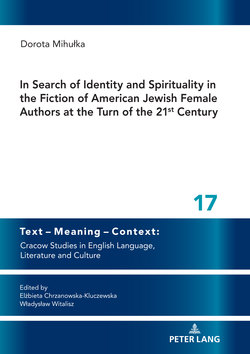In Search of Identity and Spirituality in the Fiction of American Jewish Female Authors at the Turn of the 21st Century

Реклама. ООО «ЛитРес», ИНН: 7719571260.
Оглавление
Dorota Mihulka. In Search of Identity and Spirituality in the Fiction of American Jewish Female Authors at the Turn of the 21st Century
In Search of Identity and Spirituality. in the Fiction of American Jewish. Female Authors at the Turn of the. 21st Century
Text – Meaning – Context:
Отрывок из книги
Dorota Mihułka
Dorota Mihułka is a lecturer at Department of English at Krosno State College (Poland), where she teaches American history and culture as well as practical English courses. Her academic interests include American ethnic female literature, American Jewish female literature as well as intercultural education and communication.
.....
The founder and first leader of the new movement was a German rabbi, Samson Raphael Hirsch (1808–1888) who proposed the idea of Torah in Derekh Eretz (‘Torah with the way of the land’ or ‘Torah with worldly culture’) as its central philosophy. Thus, he advocated a new style of Jewish living that combined full observance of Halakhah in the home and synagogue, with full participation in the modern economic and cultural life of the wider society. It was such a fruitful concept that the Neo-Orthodox movement (the ideological forerunner of Modern Orthodoxy) became a dynamic, successful movement first in Germany, and then, in the twentieth century, in the United States and in Israel.
Prior to World War II, Modern Orthodoxy represented a dominant voice in Orthodox circles in the United States. It developed mainly as a reaction to the Orthodoxy of the Yiddish-speaking immigrant generation. A key dividing line between ‘old immigrant’ and ‘modern American’ Orthodoxy was the use of the English language in sermons and publications by the latter. After World War II, a ‘new Modern Orthodoxy,’ in many ways similar to its Israeli counterpart, emerged in the United States. (cf. Brown, 2003: 331; Robinson, 2011: 343). Modern Orthodoxy, however, was overwhelmed and challenged by an inundation of mostly Ultra-Orthodox rabbis who, having watched the devastation of European Jewish life during World War II, were determined to rebuild it in America. As Jonathan Sarna puts it, “[w];ith the destruction of European centers of Jewry, some felt that they could take no chances with modernity; the specter of further losses to the Jewish faith brought on by assimilation overwhelmed them” (2004: 306).23 Jack Wertheimer claims in his influential work A People Divided: Judaism in Contemporary America (1993) that the movement lost some of its dominance in the latter part of the twentieth century, as many mainstream Orthodox Jews became more traditional. Generally; what has been observed within Orthodox Judaism since the 1970s is a move towards greater exactitude in Halakhic observance, often ←49 | 50→characterized as a ‘shift to the right.’ Many Modern Orthodox Jews today prefer the term ‘Centrist Orthodoxy,’ introduced by Rabbi Norman Lamm, to show that they have become stricter in their observance, moving towards the right on the spectrum of Jewish groups and farther away from liberal forms of Judaism.
.....